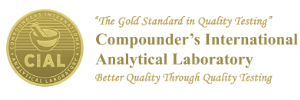
Pills and Solutions
Many States are requiring stability studies of compounded formulations to be subjected to more stringent testing. The testing now can include, not only Beyond Use Dating (BUD), but a full gambit of stability indicating assay tests performed on the active ingredients. If the formulation contains, creams, gels, solutions, suspensions or even injectables, an AET is often required. The AET determines the “life span” (effectiveness) of agents put in a formulation to prevent microbial growth in the formulation. This can become expensive for compounders, so we at CIAL try our best to control the cost. We can offer the AET as a stand alone test or as a part of meeting the requirements to determine the duration of a formulation.
The AET is very involved, labor intensive and takes 28 days to complete. CIAL follows USP <51> exactly to conduct the test. It requires a total of 55 mls of sample. The sample is inoculated with three bacteria, one mold, and one fungus, dictated by the USP. The sample is then incubated for several days. The samples are observed for any microbial growth at baseline, seven days, fourteen days, and twenty-eight days. The colony count should decrease at each time point, indicating the antimicrobial agent used is effective in preventing growth for twenty-eight days. The USP has determined if growth is prevented for twenty-eight days, it should be effective until the end of the BUD. This test is not only applicable to sterile products, but to non-sterile creams, gels or solutions that could “spoil” and support microbial growth over time.
While your state may not require an AET, be aware that state into which you ship product may.
